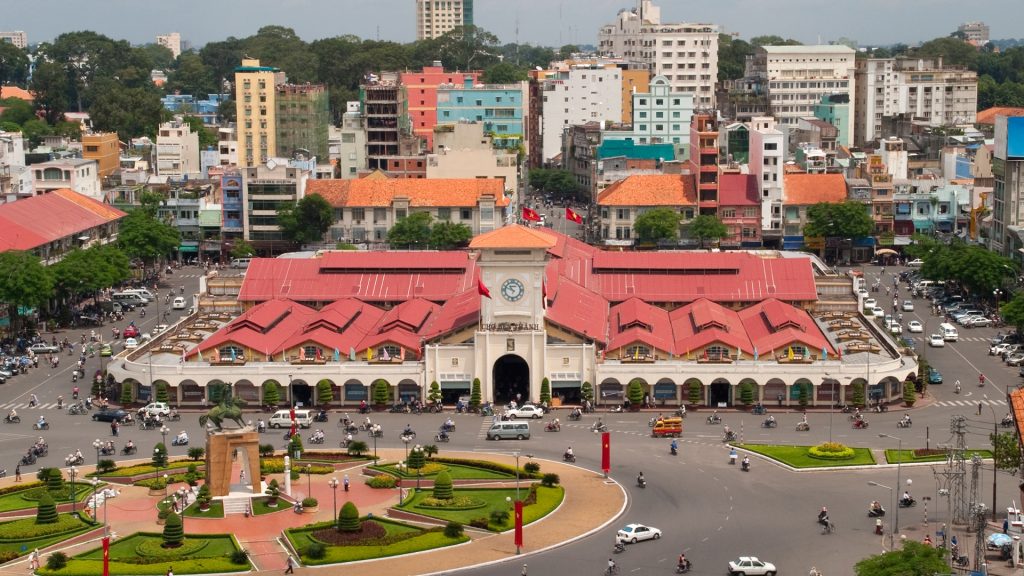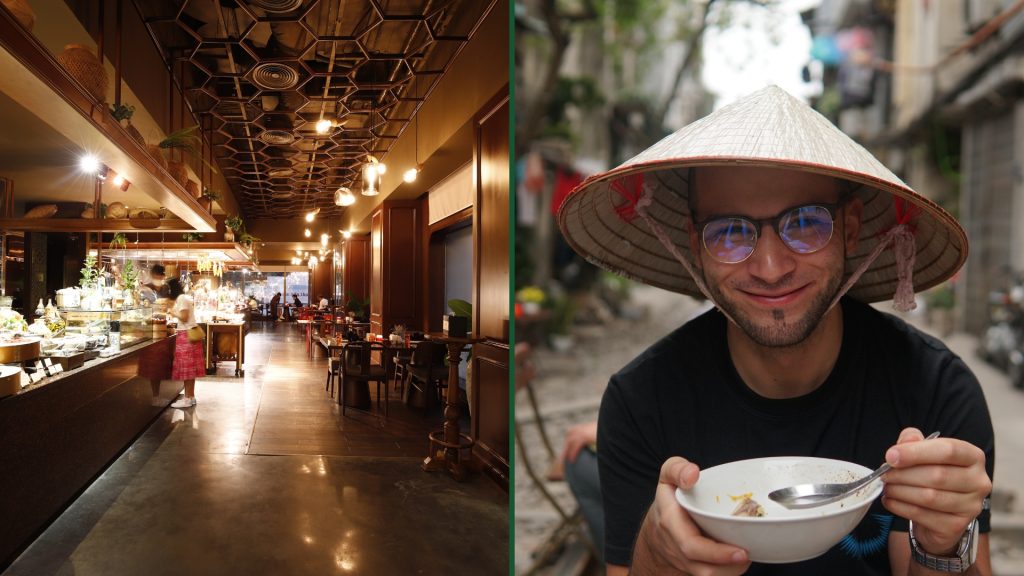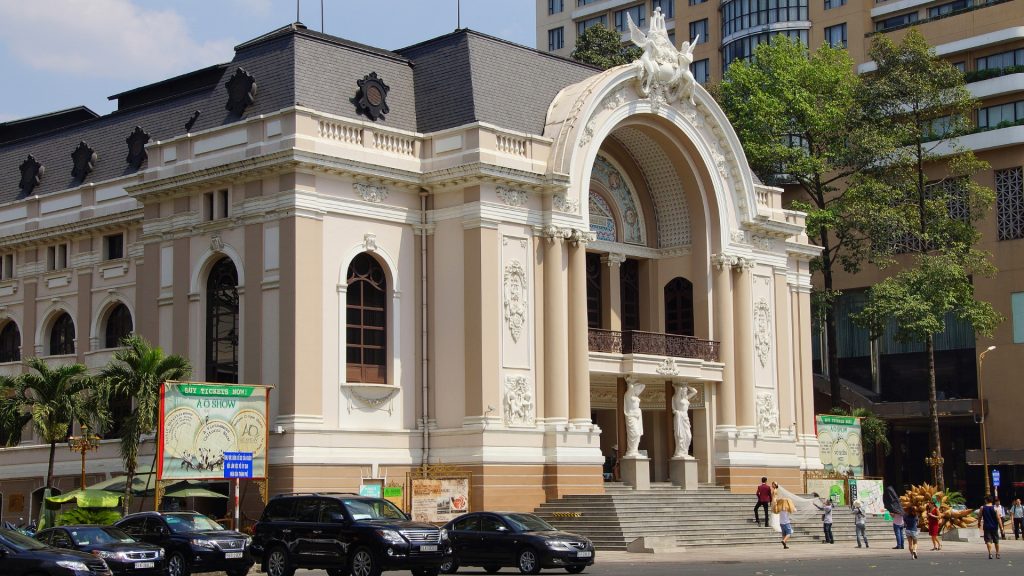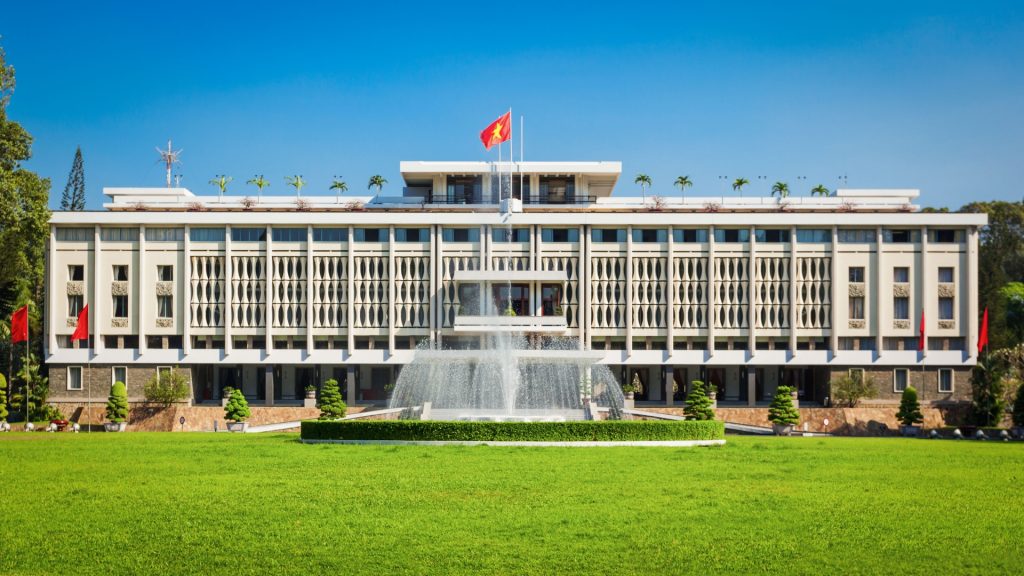My name is Niall Mackay, the podcast host of A Vietnam Podcast. I started this podcast in 2019, with a love for podcasts and Vietnam as well. You’ll find stories, experiences, and insights related to Vietnam here.
In this special episode, I’m joined by two of my closest friends, who also happen to hold a unique place in the history of this podcast. First, there’s Lewis Wright, the talented composer behind our intro music—music that, to this day, gets more compliments than the podcast itself! And then there’s Kim Nguyen, his wife and partner, who was the very first guest I ever interviewed for A Vietnam Podcast.
Together, we’re kicking off a brand-new mini-series where we’ll guide you through the best things to see and do across Vietnam. Today, we’re starting in Saigon. From its famous landmarks to hidden gems, we’re taking you on a walking tour through the city’s must-visit spots.
Exploring Ben Thanh Market: A Blend of Memories and Culture
One of the first stops on our Saigon adventure was the iconic Ben Thanh Market. It’s a place filled with energy, where the old charm of Saigon meets the buzz of tourists exploring for the first time.
I grabbed a Ba Ba Ba (333) beer, which was the first beer I ever had in Saigon, and honestly, it was not great—but I had to grab one for nostalgia. Kim and Lewis, however, went for different drinks. Along with that, we dug into some local dishes: I had bún bò lá lốt, Kim chose bánh canh cua (a crab noodle soup), and Lewis went for the classic bún thịt nướng.
As we ate, I asked Kim, a native Saigon, what she’d recommend to tourists who had just been in the city for one day. Her answer? Start at Ben Thanh Market, where you can grab local items like dried nuts or iconic fruits like dragon fruit, jackfruit, or even the infamous durian. “The smell might be off-putting,” she warned, “but the taste is worth a try!”

I admitted I’ve tried durian before—and didn’t like it—but at least I gave it a go. Kim encouraged that attitude. The market itself felt like a step back in time for Kim. Growing up, it was a hub for locals buying daily essentials. Now, though, it’s mostly a tourist attraction, filled with souvenirs, fake branded goods, and busy vendors eager to haggle. Kim shared stories of her mum visiting the market to stock up for holidays, always negotiating prices with a sharp eye.
Vietnamese Cuisine and Street Food
We talked about Vietnam’s reputation for incredible food, from noodle soups like phở and bún bò Huế to dishes like cơm tấm (broken rice) and bánh xèo (Vietnamese savory pancakes). Funnily enough, while phở is the dish most people associate with Vietnam, it’s not my top pick. Kim reminded us that phở actually originates from the north, while southern staples like cơm tấm and bún thịt nướng deserve just as much recognition. For me, phở is like a gateway dish—it introduces you to Vietnamese food, but once you’ve tried it, there’s so much more to explore.
One of the unique things about food in Vietnam is how the setting plays a role. Imagine eating a steaming bowl of soup in the heat of the day, sitting on a tiny plastic stool at a street-side market, sweat dripping down your face. It sounds intense, and it is, but somehow it works. Kim laughed as she pointed out that in cooler countries, people enjoy meals indoors in cozy restaurants, but in Vietnam, it’s all about embracing the heat, spice, and chaos of the streets.
We also joked about how spicy food can get here. I tend to overdo it sometimes, adding too much chili to my broth until it’s bright red and practically inedible.
Vietnam’s food culture isn’t just about the dishes themselves—it’s about the experience. Whether it’s haggling over snacks at Ben Thanh Market, sweating over a bowl of spicy soup, or learning the stories behind each dish, every meal here feels like a deep dive into the heart of the country. And honestly, even after all this time, I know I’ve barely scratched the surface of what Vietnamese cuisine has to offer.
Related Episode: What Vietnamese Food I Eat in Saigon
Shopping Experience: Saigon Square and Saigon Center
After the chaos and heat of Ben Thanh Market, we made our way to Saigon Square, just a short walk down Le Loi Street. Saigon Square felt like a completely different experience—air-conditioned, organized, and much quieter. It was a nice break from the relentless buzz of honking motorbikes and the constant calls from market vendors.
Kim explained that Saigon Square is a favorite among tourists because of its fixed prices, though there’s still some room for bargaining. The stalls here are packed with clothes, bags, and accessories—plenty of it brand-name knockoffs, which led us to a fun debate about whether the items were fakes.
One thing that stood out was how different this market felt compared to the street markets in the UK. Kim pointed out that while markets back home might be more spacious and less hectic, here in Vietnam, they’re all about squeezing in as much as possible. The tight aisles make it hard to move around, but it adds to the experience.
Before we wandered inside, I noticed a few guys offering shoe-cleaning services. It’s common to get approached here, but to my surprise, not one of them actually offered to clean my shoes. Maybe my shoes looked cleaner than I thought!
For anyone visiting Saigon, I’d recommend checking out Saigon Square for a less overwhelming shopping experience. It’s cooler, calmer, and a great spot to pick up a few bargains. Whether you’re looking for souvenirs or just soaking up the atmosphere, it’s a fantastic way to balance out the intensity of places like Ben Thanh Market.
Saigon Centre and Beyond
After exploring Saigon Square, we decided to check out Saigon Centre, a more upscale shopping destination. Unlike the markets, this place is air-conditioned and home to international luxury brands like Gucci and Chanel. It’s a completely different vibe—less chaotic but just as fascinating.
One thing to note about shopping for real brands in Vietnam is the price. Many goods are made here, shipped overseas for packaging, and then reimported, which means you’re often paying more than you would in the West due to import taxes. So, while Saigon Centre is great for window shopping and grabbing a free sample of Chanel perfume, you might want to think twice before splurging.
Discovering Saigon’s Layers
As we left Saigon Centre and strolled down the street, Kim pointed out something I’d never noticed before. Above the girly bars —where men buy drinks for women to keep them company—there’s a whole other world of Gen Z hangouts.
We climbed the narrow stairs of an old, crumbling building that used to be residential but is now packed with trendy shops, cafes, and even a charity store. It’s fascinating how Saigon layers the old with the new. Beneath us were bars with a somewhat notorious reputation, while above, young Vietnamese people were sipping drinks, snapping photos, and shopping for street food.

Kim teased me about the height difference as I ducked to avoid hitting my head on the low ceilings. Inside, the spaces were small but filled with vibrant energy—perfect for photoshoots and casual meetups. She kept emphasizing, “This is for young people, not for you,” which became an ongoing joke during our visit.
The Juxtaposition That Defines Saigon
This part of Saigon perfectly captures what I love most about the city: its contrasts. One moment you’re in a luxury shopping mall; the next, you’re walking through a buzzing market or climbing a staircase to find hidden gems. It’s these unexpected juxtapositions that make Saigon so unique and endlessly interesting.
Whether you’re exploring high-end malls or discovering quirky Gen Z hangouts in repurposed buildings, Saigon always has something surprising around the corner.
Explore More: Top 11 Cocktail Bars in Ho Chi Minh City
Nguyen Hue Walking Street and More

After leaving Saigon Centre, we headed towards Nguyen Hue Walking Street I struggled a bit with the pronunciation, and we had a laugh recalling some of the funny mispronunciations my friend Lewis had made in the past. Nguyen Hue is a bustling street filled with a mix of history and modern-day activities.
Just 2 days ago, people gathered at Nguyen Hue Walking Street to watch the final football match between Vietnam and Thailand, I will never forget this occasion with the “Di Bao” experience.
You mustn’t miss this too, watch NOW!
The street leads up to the Ho Chi Minh City People’s Committee Building, a stunning French colonial structure. Kim explained that this was a government building, and at the top stood a statue of Ho Chi Minh himself. Despite the heat—nearly unbearable at mid-afternoon—we could imagine how lively it would become later. As Kim noted, Vietnamese people generally avoid the streets during the day due to the heat, but by evening, Nguyen Hue had transformed into a vibrant hub. Young locals skate, hang out with pets, and enjoy street food as the street comes alive with food carts and market stalls.
The Opera House and Dong Khoi Street: A Glimpse of Saigon’s Elegance
Next, we visited the Saigon Opera House, a beautiful French colonial building that truly captures Saigon’s elegance. It sits next to the historic Hotel Continental, which has its own charm and a slice of literary history. Graham Greene wrote The Quiet American there, a novel I highly recommend for its unique wartime love story.
What’s fascinating about this area is the sharp contrast between old and new. Surrounding these colonial-era landmarks are high-end boutiques like Louis Vuitton, Fendi, and Hermes. Kim and I reflected on how these luxury stores aren’t just for tourists; Vietnamese shoppers frequent them too. It’s a reminder of how far Saigon has come—a city where the past and present collide in the most interesting ways.

Independence Palace: Where History Was Made
Our final stop was Independence Palace, a place steeped in history. It’s the site where, on April 30, 1975, tanks rolled through the gates, marking the end of the Vietnam War against America. Walking up Le Duan Street, I could almost imagine the scenes from that pivotal day.
This was also the day when many people fled the country. You might recall those iconic images of helicopters evacuating people from the American Embassy—it all happened just around the corner. The palace itself stands as a symbol of both the country’s resilience and its turbulent history.

We wrapped up our day in Saigon the best way possible—with a cold drink at Au Park, right next to Propaganda, one of the first restaurants I ever visited in this city. Propaganda serves incredible Vietnamese dishes like cơm tấm (broken rice). Sure, it’s more expensive than street food, but it’s also much cleaner. Sometimes you’re willing to pay for that peace of mind!
For those planning a visit, the rainy season runs from May to December. The rain usually doesn’t last long and can actually be refreshing after the heat, but it’s worth knowing that some areas can flood. If you’re looking for cooler weather, December is a great time to visit.
Not only by foot, I also explore Saigon from ABOVE. Sounds interesting, right? Let’s listen to this episode to find out: The Hop On Hop Off Bus Experience
Final Thoughts
In one day, we managed to cover some of Saigon’s greatest hits—Nguyen Hue Walking Street, the Opera House, and Independence Palace. Each place added a different layer to my appreciation for this city. From its historical significance to its modern vibrancy, Saigon is a place that never fails to amaze me.
To really appreciate Saigon, I’d suggest spending a couple of days here, exploring its food, culture, and history. And if you have extra time, take a day trip to the Cu Chi Tunnels or the Mekong Delta—two incredible experiences just outside the city.
This is just the beginning of a six-part series, so be sure to stick around, subscribe, follow, and turn on notifications to stay updated.
Let me know what you want me to explore in Saigon or Vietnam, and become part of our community here.
Click here for Adventure Travel inspiration from our friends at Explore Worldwide. Don’t Just Travel, Explore.


13 thoughts on “Explore the Saigon Sights with Kim Nguyen and Lewis Wright”
Comments are closed.